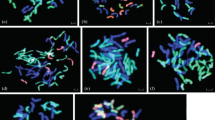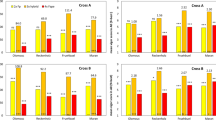Abstract
-
1.
In attempts to intercross Lolium perenne and L. multiflorum with Festuca pratensis in a glasshouse, 13,284 emasculated flowers of diploid, triploid and tetraploid Lolium plants were provided with pollen of diploid and tetraploid Festuca plants. Only the combinations 2n\sx4n and 3n\sx4n produced hybrids, viz. on average 5.3 and 1.0 mature hybrid plants per 100 pollinated flowers. In crosses performed in winter these averages were 12.0 and 4.9 respectively.
-
2.
Non-emasculated spikes of diploid, triploid and tetraploid plants of L. perenne and L. multiflorum in the field were enclosed in pergamine bags with panicles of diploid, triploid and tetraploid plants of F. pratensis. Apart from the above-mentioned combinations hybrids were also obtained of the crosses 2n\sx2n and 2n\sx3n. The number of hybrids produced per inflorescence was on average nearly as high as in corresponding crosses in the glasshouse.
By bagging together spikes of self-incompatible diploid plants of L. perenne and L. multiflorum with panicles of tetraploid plants of F. pratensis in the field, large numbers of triploid hybrid seeds may easily be obtained. This opens the possibility of using seed treatment with colchicine for the production of hexaploids.
-
3.
Triploid hybrids showed a better production in spring and a better aftermath growth in summer than either parent plants. Spontaneously obtained hybrids were more winterhardy than most winterhardy indigenous types of perennial ryegrass.
-
4.
All artificial and most natural hybrids had no dehiscent anthers; the percentage of normal pollen varied in the artificial hybrids from 0 to 3.8%, in the natural hybrids from 0 to 10%. Several plants in both groups were slightly female fertile. Some plants with hybrid characters, collected from natural grassland, had dehiscent anthers and more than 75% stainable pollen; their female fertility was fairly good.
-
5.
Open pollinated seeds of triploid male sterile hybrids produced, apart from a majority of plants closely resembling the parent species, or the F1 hybrids, also types with new combinations of characters. The male fertility was considerably higher than in the previous generation: several plants had dehiscent anthers. In spontaneous families of the male fertile hybrid forms greatly deviating types of Lolium occurred.
-
6.
Some possibilities of the various cross combinations for the breeding of ryegrasses are discussed.
Samenvatting
-
1.
In een kas werden 103 kruisingen beproefd tussen 56 planten van Lolium perenne en Lolium multiflorum als moeder en 27 planten van Festuca pratensis als vader. In totaal werden 13.284 gecastreerde bloempjes van diploide, triploide en tetraploide Lolium-planten bestoven met stuifmeel van diploide en tetraploide Festuca-planten. Alleen de combinaties 2n\sx4n en 3n\sx4n leverden hybriden op, nl. gemiddeld respectievelijk 5,3 en 1,0 volwassen bastaardplanten per 100 bestoven bloempjes. Bij de kruisingen, die in de winter werden uitgevoerd waren deze gemiddelden resp. 12,0 en 4,9.
-
2.
Ongecastreerde aren van diploide, triploide en tetraploide planten van L. perenne en L. multiflorum werden op het veld in pergamine zakken ingehuld met pluimen van diploide, triploide en tetraploide planten van F. pratensis. Behalve van de bovengenoemde combinaties werden ook hybriden verkregen van de kruisingen 2n \sx2n en 3n\sx4n. Het aantal per aar geproduceerde hybriden was gemiddeld ongeveer even hoog als bij overeenkomstige kruisingen in de kas.
Door aren van zelfincompatibele diploide planten van L. perenne en L. multiflorum op het veld samen in te hullen met pluimen van tetraploide planten van F. pratensis kunnen gemakkelijk grote aantallen triploide bastaardzaden worden verkregen. Dit maakt zaadbehandeling met colchicine, voor het verwekken van autoallohexaploiden, in de praktijk uitvoerbaar.
-
3.
Triploide hybriden vertoonden een grotere voorjaarsproduktie en een betere nagroei in de zomer dan de ouderplanten. Spontaan verkregen natuurlijke bastaarden waren winterharder dan de meest winterharde inheemse typen van Engels raaigras.
-
4.
Alle kunstmatige en de meeste natuurlijke hybriden hadden niet-openspringende meeldraden; het percentage normaal lijkend stuifmeel varieerde bij de eerste van 0 tot 3,8%, bij de laatste van 0 tot 10%. Verschillende planten van beide groepen waren zwak vrouwelijk fertiel. Enkele in de natuur gevonden planten met bastaardkenmerken hadden openspringende meeldraden en meer dan 75% \ldgoed\rd stuifmeel; zij waren vrij goed vrouwelijk fertiel.
-
5.
Spontane zaailingen van triploide manlijk steriele hybriden gaven naast een meerderheid van planten die sterk overeenkwam met de oudersoorten of met de F1 generatie, ook typen met nieuwe combinaties van eigenschappen. Het percentage goed stuifmeel was aanmerkelijk hoger dan in de voorgaande generatie, verschillende planten hadden openspringende meeldraden. In spontane families van de manlijk fertiele bastaardvormen kwamen sterk afwijkende vormen van Lolium voor.
-
6.
Enkele mogelijkheden, die de verschillende kruisingscombinaties voor de veredeling van raaigrassen bieden, werden besproken.
Similar content being viewed by others
References
Carnahan, H. L. and H. D. Hill, Lolium perenne L. × tetraploid Festuca elatior L. Triploid hybrids and colchicine treatments for inducing autoallohexaploids. Agronomy Journal 47 (1955): 258–262.
Crowder, L. V., Interspecific and intergeneric hybrids of Festuca and Lolium. Journal of Heredity 44 (1953): 195–203.
Essad, S., Analyse cytogénétique de deux amphidiploïdes Lolium perenne L. × Festuca pratensis Huds. Comptes Rendus Acad. des Sciences (Paris) 243 (1956): 670–672.
Jenkin, T. J., Interspecific and intergeneric hybrids in herbage grasses. Initial crosses. Journal of Genetics 28 (1934): 205–264.
Jenkin, T. J., Interspecific and intergeneric hybrids in herbage grasses. X. Some of the breeding interactions of Festuca gigantea. Journal of Genetics 53 (1955): 94–99.
Jenkin, T. J., Interspecific and intergeneric hybrids in herbage grasses. XII. Festuca capillata in crosses. Journal of Genetics 53 (1955): 105–111.
Jenkin, T. J., Interspecific and intergeneric hybrids in herbage grasses. XIII. The breeding affinities of Festuca heterophylla. Journal of Genetics 53 (1955): 112–117.
Jenkin, T. J., Interspecific and intergeneric hybrids in herbage grasses. XIV. The breeding affinities of Festuca ovina. Journal of Genetics 53 (1955): 118–124.
Jenkin, T. J., Interspecific and intergeneric hybrids in herbage grasses. XV. The breeding affinities of Festuca rubra. Journal of Genetics 53 (1955): 125–130.
Jenkin, T. J., Interspecific and intergeneric hybrids in herbage grasses XVI. Lolium perenne and Festuca pratensis with references to Festuca loliacea. Journal of Genetics 53 (1955): 379–441.
Author information
Authors and Affiliations
Rights and permissions
About this article
Cite this article
Wit, F. Hybrids of ryegrasses and meadow fescue and their value for grass breeding. Euphytica 8, 1–12 (1959). https://doi.org/10.1007/BF00022083
Received:
Issue Date:
DOI: https://doi.org/10.1007/BF00022083




